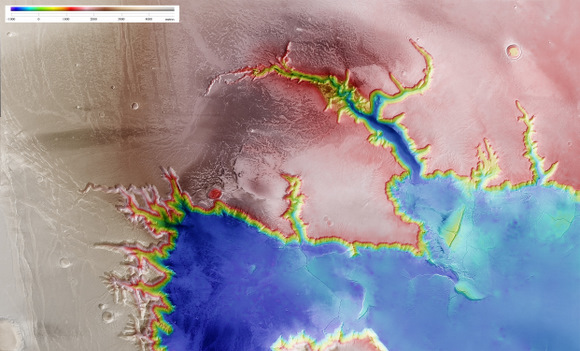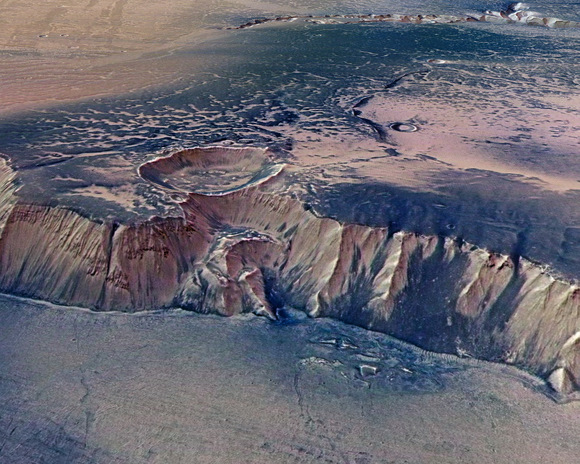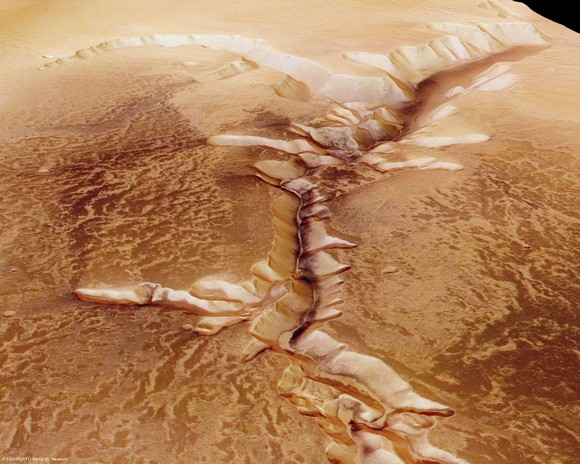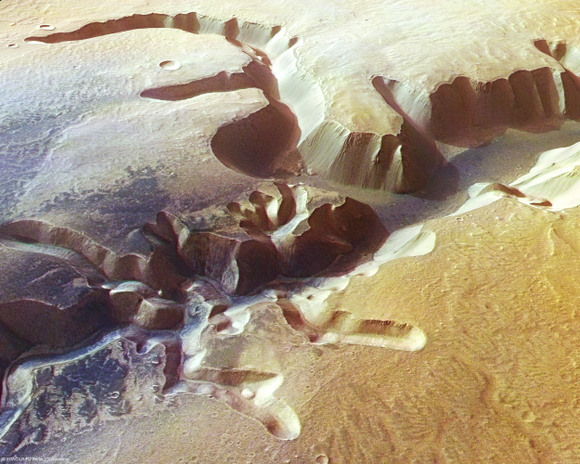Do these valleys on Mars come from gushes of water from past rainfall, or groundwater springs, or could they have possibly been formed from magma flows on Mars surface? That’s the debate surrounding the many valleys, chasms and dry gullies found on the Red Planet.
The majority of planetary geologists seem to favor the idea of water flowing on Mars surface in the past. The images shown here of Echus Chasma are from the European Space Agency’s Mar’s Express, and its High-Resolution Stereo Camera (HRSC). Echus Chasma is believed to be one of the largest water source regions on the Red Planet. The valleys, cut into the landscape look similar to drainage networks found on Earth.
The image here has a ground resolution of approximately 17 m/pixel, and is so clear and distinct it almost makes you feel like you’re there!

Echus Chasma is approximately 100 km long and 10 km wide. Echus Chasma is believed to be the water source region that formed Kasei Valles, a large valley which extends thousands of kilometers to the north. It’s located in the Lunae Planum high plateau, north of Valles Marineris – the Grand Canyon of Mars. This image indicates elevation data, also obtained by the HRSC.

An impressive cliff, up to 4000 m high, is located in the eastern part of Echus Chasma. Possibly, gigantic water falls may once have plunged over these cliffs on to the valley floor. The remarkably smooth valley floor was later flooded by basaltic lava.

The smaller valleys, also called sapping canyons, are believed to originate from the discharge of groundwater.
Original News Source: ESA


That image is more clear than using my own eyes to view the US southwest from an airplane cabin window. Wow!
Thanks for the images. I don’t think they are the actual colors – do you know? I really wish we could get some actual color photos from HiRise or the other orbiters. I’m sure this is done for some scientific reason, but my mind doesn’t think well in pseudocolor.
Thanks
I would also like to see how these line up with Slipher’s “canals”.
Has anyone considered that it might be upper crust collapse in to caverns or tectonic rift?
“# Woodrow Says:
July 14th, 2008 at 5:10 pm
“Has anyone considered that it might be upper crust collapse in to caverns or tectonic rift?”
>>>I’d say they would have – they’ve got a lot of top-shelf geologists working on this…
@Astrofiend NASA, ESA, JAXA and others have usually surrounded themselves with great people, but, there is a very long list of very simple things gone awry.. often because no-one has stopped to ask the most fundamental of questions. I’m thinking the metric / imperial Mars Climate Orbiter as a prime example .. the simple questions & answers are sometimes overlooked and always worth ‘throwing out there’ 😛
Cheers,
al.
Its cool imagine our great grand kids walking around down there.
I hope it does’nt turn out like Total Recall or Doom….
It could also be formed by dust and sand the same way as gullies here on earth. The low gravity and extremely dry conditions might combine to form such features. There’s also the possible action of water vapour combining with the dust to add to the effect.
My 5 cents worth 🙂
Yeah, that would be cool
I HOPE it turns out like Doom3!
Great imagery! I’ve always felt that Valle Marinarus was caused by the giant impact that caused the huge basin on the other side of Mars – an antipodal feature. I never have seen how liquid water could possibly exist when the temperatures have never been high enough to melt ice. I feel the huge canyon was never eroded by water. I’m still waiting to see the analytical data from Pheonix. My mind can be changed with some solid evidence for water, although I’d still like to know how it can exist as a liquid at sub-zero temperatures.
Possibilities: surface temperature much higher after formation and/or much denser atmosphere than now and/or an early sun emitting more energy.
I think I see several impact craters within Echus chasma, which probably says it was formed early in the history of Mars.
Neoguru – the temperature near the equator certainly gets high enough to melt ice. The surface can get to 80 degrees F or more. The fact that some parts of Mars reach a warm surface temperature is a very rarely published fact in Mars science. The pressure to retain water is another question – perhaps when the great volcanoes there erupted, the pressure was higher for a while. Many features on Mars look like they were carved by liquid water, so I think the question is how long ago did the free flowing water exist?, was it brine?, did it contain life? etc.
The pictures are great, but one should keep in mind that the real height of the objects shown is five times less than these pictures indicate: The height is enhanced deliberately, in order to enhance the visibility of small differences of slope angle. This is a common method that is and has been executed on many pictures of the planets, e. g. the famous pictures of venusian volcanoes based on the magellan spacecraft radar scans. In fact, the slopes shown are much flatter and the mountains are less high and such the landscape is less “dramatic” than the pictures indicate.
The color of the pictures is more or less a guess, as the the color is not inherent in the pictures taken on Mars, but is added during picture processing.
It is difficult to tell the color objects in our solar system “really” have. When the astronauts of Apollo 17 returned from the moon, they spent hours discussing which color the moon was. The composition of light is different in space, and objects in space reflect light differently, as surfaces there are weathered by cosmic and solar radiation and microparticles in a different way than surfaces are weathered on our planet, and this influences surface´s ability to absorb or reflect light and color.
Regards,
Günther
With photos like that I want to go and visit Mars now. These photos are breathtakingly spectacular. Come on NASA get us there cheaply and safely so I can afford to go before I get too old.
I recall reading on the ESA website that a main reason for coloring the pictures the way they do is to filter out the optical effects of dust in the Martian atmosphere. Anyone? Bueller??
Are we sure these are not just huge sink holes? This is another planet after all that we know nothing about. I was just wondering after I came apon these pictures and I just couldn’t see liquid erosion. And we know nothing about the enter working of Mars.
Looks a lot like downtown D.C. in Fallout 3. Beware radroaches!